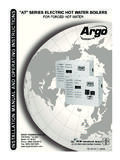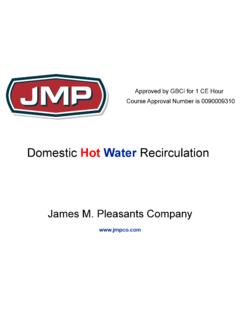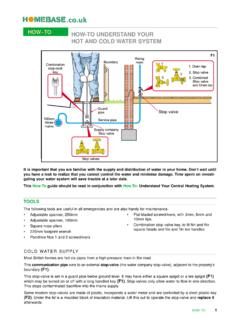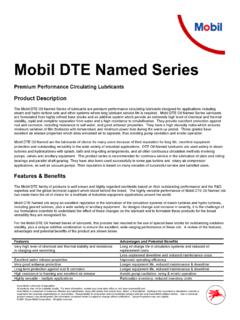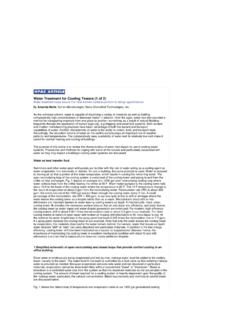Transcription of Cooling Tower Cycles of Concentration - AGI Water
1 Cooling Tower Cycles of ConcentrationAs pure Water is evaporated, minerals are left behind in the recirculating Water . As evaporationcontinues, the Water becomes more concentrated than the original make up Water . Thiseventually can lead to saturated conditions. The term Cycles of Concentration compares the levelof solids of the recirculating Cooling Tower to the level of solids of the original raw make up the circulating Water has four times the solids Concentration than that of the make up Water ,then the Cycles are offis the process of removing a portion of concentrated recirculating Water , which isobviously replaced with fresh make up Water .
2 By specifying a certain amount of bleed off we limitthe Cycles of Concentration the system can operate at, thus controlling scale formation. Varioustreatments will let us operate at various Cycles depending on the make up Water analysis andheat loading of the Tower . Bleed off is critical to a successful treatment program. The preferredmethod of bleed off control is with the use of automated bleed off control. This includes acontacting head Water meter, dual timer, chemical pump and solenoid controlled bleed off )Evaporation Loss:from a Cooling Tower (E) =.
3 001 (Cr) ( T) where Cr= circulation ratein gallons per minute and T = temperature differential between hot and cold Water in evaporation rate amounts to 1% of the recirculation rate for every 10 F )Windage Loss:This is a relatively small amount of entrained Water lost as fine dropletsin the air discharge from a Tower . Unlike evaporation which does not contain dissolvedimpurities windage carries these impurities with it and reduces dissolved solids in thecirculating Water . Typical values are to of the circulating rate for mechanicaldraft )Bleed off:In the evaporation process the non volatile impurities in the make up Water areconcentrated.
4 To prevent excessive Concentration some of the circulating Water must beremoved from the system. This iscommonly referred to as bleed off or blowdown. Theamount of bleed off can be determined from the following equations:% B (bleed off) + % (windage) = % E (evaporation loss) / ( Cycles -1)D) Cycles :The previous equation added a new turn to the mix . Cycles !!!!!!!! This is one ofthe most difficult terms to understand. I will now attempt to define Cycles of NACE defines it as: A measure of the degree to which dissolved solids are beingconcentrated in the circulating Water .
5 It is in effectthe inverse of blowdown. As purewater is evaporated all of the solids are left behind so they concentrate in the coolingtower Water . If we start out with fresh Water the Tower has one cycle of all the fresh Water is evaporated ( solids are still in the Tower ) the Tower then refillsitself with more fresh Water and we have twice the solids in the Tower . We now have twocycles of Concentration . This process will proceed and scale will form at a certain use bleed off to preventthe Tower from reaching the point of scale formation.
6 In anactual Tower , this is an ongoing process with continuous addition of make up Water andcontinuous bleed off. The allowable Cycles of Concentration will be determined by thelaboratory. They are based on Water analysis, heat transfer rate of the equipment, andfeed equipment present. We normally use chloride to determine the number of Cycles atower is operating at. The following equation can be used for this calculation:Chlorides in Tower Water / Chlorides in make up Water = Cycles of concentrationFor example, a Tower operating at a 450 gallons per minute recirculating rate (Cr) , 5cycles of Concentration , 10 T, and windage loss:%B +.
7 1% = 1% / (5-1)which is %B = .25%- .1% therefore%B = .15% of the circulating = (450 gallons/minute) which is gallons of bleed off make up Water requirements for the system are:Bleed off gallons per minuteEvaporation 1% (450 gallons/minute) = gallons/minute Windage (450gallons/minute) =.45 gallons/minuteTotal make up Water = gallons/minuteTotal make up Water per hour is = 60 minutes/hr. ( gallons per minute)= gallons per you can see the higher the Cycles the less make up Water and blowdown are is true to a certain point where additional Cycles do not decrease the amount ofmake up Water and blowdown as drastically.
8 The following graph illustrates the point. Asyou can see at about Cycles the curve starts leveling off which indicates higher cycleswill not effect thequantityof make up Water drastically.

